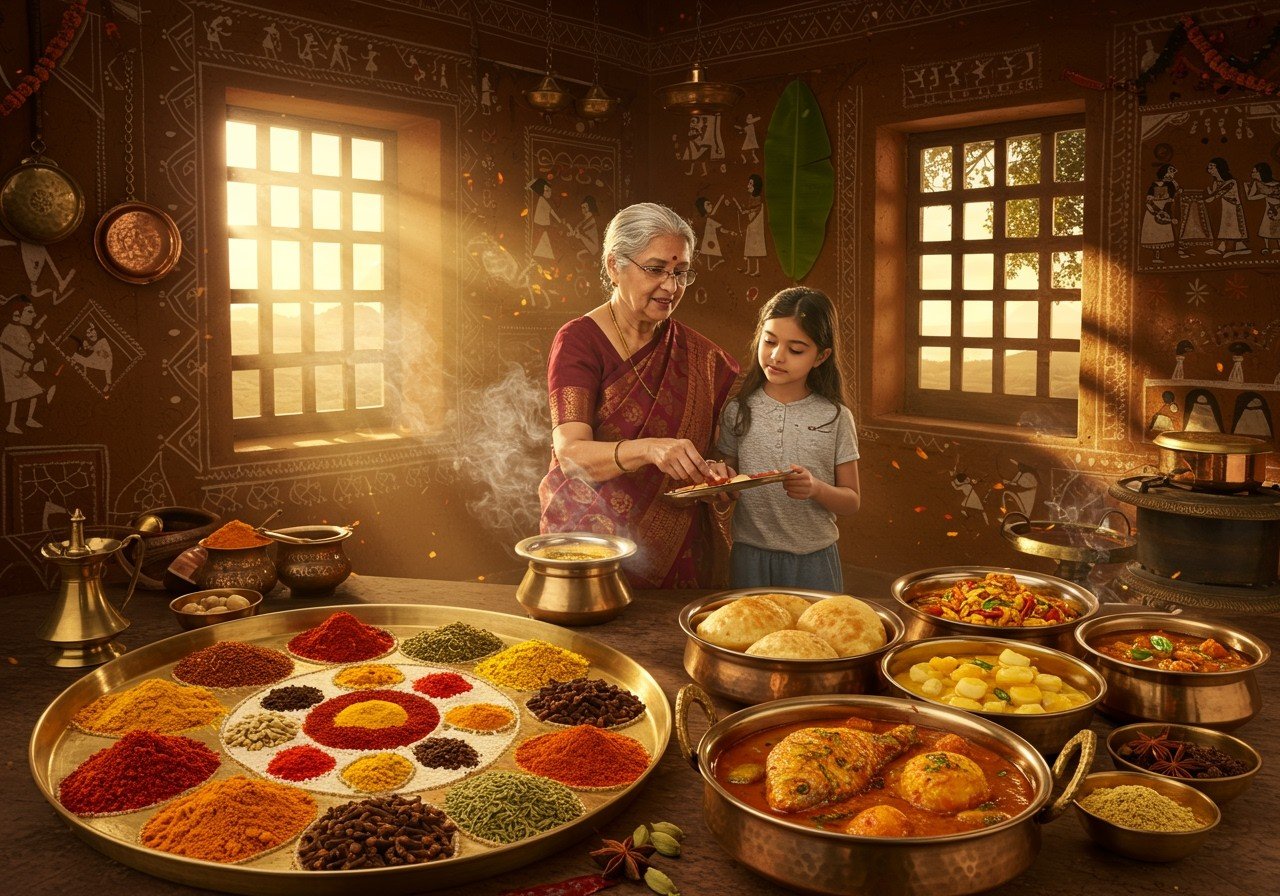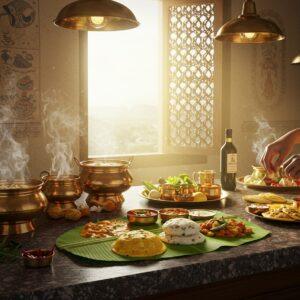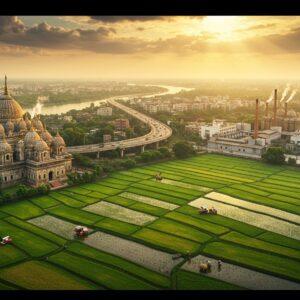
Embark on a culinary adventure through Western India, a region renowned for its diverse flavors, rich spices, and deep-rooted traditions. From the coastal delights of Goa to the vibrant street food of Maharashtra and the vegetarian specialties of Gujarat, each state offers a unique gastronomic experience. The geography, climate, and cultural influences of the region play a significant role in shaping its distinctive culinary identity. Food in Western India is not merely sustenance; it’s an expression of cultural heritage, a symbol of community bonding, and a celebration of life itself.
Famous Food of Western India – Iconic Dishes and Delicacies
Western India’s culinary landscape is dotted with iconic dishes. Maharashtra is famous for its Puran Poli, a sweet flatbread filled with jaggery and lentils, often enjoyed during festivals. Gujarat boasts Dhokla, a fermented steamed cake made from rice and chickpea batter, known for its spongy texture and tangy flavor. Rajasthan offers Laal Maas, a fiery meat curry made with red chili peppers. Coastal Goa delights with its Goan Fish Curry, a spicy and tangy dish influenced by Portuguese cuisine. These are just a few examples of the region’s rich culinary offerings. For a more in-depth look at Goan cuisine, check out resources like ThePepperCook blog, which shares various Western Indian recipes, including Goan-inspired dishes.
Traditional Food of Western India
Beyond the iconic dishes, Western India’s culinary traditions offer a deeper insight into its vibrant culture.
- The Thali: A platter showcasing a variety of dishes, offering a balanced and sensory-rich meal, celebrating diverse flavors and textures.
- Festival Snacks (‘Faral’): During festivals, special snacks like Shrikhand (sweet yogurt) and Chakli (spiral-shaped savory snack) are prepared, adding to the festive spirit and bringing families and communities together. These treats represent a unique aspect of the region’s culinary heritage.
- Earthenware and Brass Utensils: Cooking in these traditional utensils enhances flavors and preserves authenticity, connecting us to ancient culinary wisdom. The aroma and taste of food cooked in these vessels offer a unique experience.
- Seasonal Ingredients: Western Indian cuisine emphasizes using fresh, locally sourced ingredients, reflecting nature’s bounty and respecting the earth’s rhythm. This practice ensures the food is flavorful and aligns with the seasons.
Food Habits of Western India
Dining customs in Western India are unique and meaningful.
- Eating with Hands: A common practice that engages all senses, making meals a more immersive and enriching experience, connecting diners more directly with their food.
- ‘Chhappan Bhog’: Offering 56 different food items to deities during religious ceremonies, a practice that showcases culinary richness and devotion. This elaborate tradition exemplifies the region’s culinary artistry.
- Fasting and Feasting: An integral part of the culture, where specific foods are consumed based on religious beliefs, promoting spiritual fulfillment and community bonding. These practices add a spiritual dimension to the culinary experience.
- Ayurvedic Influence: Ayurveda plays a role in dietary choices, emphasizing balanced meals and the harmony between body and mind, using food as a path to well-being. This holistic approach emphasizes the connection between food and health.
Spices and Ingredients
Spices are the essence of Western Indian cuisine.
- Kokum: A tropical fruit native to the Western Ghats, adds a tangy flavor to curries, lending a unique taste to many dishes. Its distinct tartness balances the richness of other ingredients.
- Staple Spices: Cumin, coriander, mustard seeds, and asafoetida are essential spices, adding depth and complexity to dishes, creating layers of flavor. These aromatic spices form the foundation of many Western Indian recipes.
- Jaggery: An unrefined sugar that balances sweet and savory flavors, enhancing both desserts and main courses. Its rich, earthy sweetness adds a unique dimension to the cuisine.
- Local Grains: Bajra (pearl millet) and jowar (sorghum) are staple grains, offering nutritional benefits and representing a long-standing part of the regional diet. These grains provide sustenance and contribute to the unique flavors of Western Indian cuisine.
Culinary Traditions and Festivals
Food plays a central role in Western Indian festivals.
- Ganesh Chaturthi (Maharashtra): Modak, sweet dumplings, are offered to Lord Ganesha, symbolizing joy and devotion. This festive treat is a highlight of the celebrations.
- Navratri (Gujarat): Special fasting foods like Sabudana Khichdi are consumed, reflecting the spirit of purity and spirituality. These dishes provide nourishment while adhering to fasting traditions.
- Makar Sankranti (Rajasthan): Dishes made with sesame seeds and jaggery are enjoyed to celebrate the harvest season, fostering communal harmony. These treats mark the season’s bounty and bring people together.
Food during festivals transcends mere taste; it’s a celebration of cultural heritage and unity.
Modern Influences and Fusion Cuisine
Western Indian cuisine continues to evolve with modern influences.
- Street Food: Urban areas are bustling with street food vendors offering innovative twists on traditional dishes, such as Pav Bhaji Fondue and Dabeli Tacos. This vibrant street food scene showcases the cuisine’s adaptability.
- Globalization: International cuisines and techniques have enriched the region’s food scene, creating exciting fusion dishes while preserving traditional roots. This fusion of flavors adds a contemporary touch to the culinary landscape.
- Digital Platforms: Food blogs and online resources, like BlogShog with its video recipes, and Feed Me Flavour with its insights into Mumbai’s food scene, make Western Indian cuisine accessible globally, helping preserve traditional recipes and promoting culinary innovation. This digital presence allows the cuisine to reach a wider audience.
This blend of tradition and modernity ensures Western Indian cuisine remains vibrant, relevant, and connected to both past and present flavors.
How Poojn.in Enhances Your Western Indian Cooking Experience
Poojn.in offers a curated selection of products to enhance your Western Indian cooking and connect you with traditional practices. For authentic culinary experiences and rituals, explore our range of:
- Pure Copper Vessels and Utensils: Traditionally used in Western Indian kitchens, these enhance the taste and nutritional value of food. Our camphor products complement these traditional cooking methods.
- Sacred Spice Boxes (Masala Dabba): Crafted from brass and copper, these spice boxes are essential for organizing and preserving the aromatic spices used in Western Indian cooking.
- Traditional Grinding Stones: Prepare fresh masalas with our traditional grinding stones for an authentic culinary experience. Green mung dal and other lentils can be ground to perfection using these stones.
These and other items are available for convenient online shopping with doorstep delivery across India. Each product comes with authenticity certification and care instructions. Our copper and brass items are especially popular for Western Indian cooking, enhancing the taste and nutritional value while respecting traditional practices.
Shop Now at Poojn.in for Traditional Cooking Items
Note: Visit our website for current prices and availability of products.
Celebrating Western India’s Culinary Heritage
Western India’s cuisine is a vibrant tapestry of flavors, spices, and traditions, reflecting the region’s rich cultural heritage and the importance of food in bringing families and communities together. Each dish, from the comforting Thali to the festive faral snacks, tells a story. From traditional cooking methods and seasonal ingredients to unique dining customs and the influence of Ayurveda, Western Indian cuisine is a celebration of flavor, health, and cultural identity. As you explore this diverse culinary world, each bite connects you to a legacy of flavors, spices, and traditions cherished for generations.
FAQs
What are some famous foods of Western India? Western India is renowned for dishes like Dhokla (Gujarat), Pav Bhaji (Maharashtra), and Vindaloo (Goa), each state offering unique and flavorful culinary experiences. Dhokla, a steamed savory cake, represents the distinct vegetarian cuisine of Gujarat, while Pav Bhaji, a spiced mashed vegetable curry served with bread, is a street food staple in Maharashtra. Vindaloo, a fiery Goan curry, showcases the region’s Portuguese influence.
Which spices are commonly used in Western Indian cuisine? Cumin, mustard seeds, turmeric, and coriander are frequently used, adding depth and aroma to the dishes. These spices form the base of many curries and other preparations, giving Western Indian cuisine its characteristic flavor profile.
How does Western Indian cuisine reflect its traditions? From the predominantly vegetarian dishes of Gujarat to the coconut-based curries of Goa and the seafood-rich cuisine of Maharashtra, Western Indian food reflects both cultural and geographical influences. These traditions are passed down through generations, preserving the unique culinary identity of each state.


